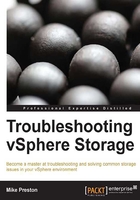
Supported filesystems
VMware ESXi supports a couple of different filesystems to use as virtual machine storage; Virtual Machine File System (VMFS) and Network File System (NFS).
VMFS
One of the most common ESXi storage configurations utilizes a purpose-built, high-performance clustered filesystem called VMFS. VMFS is a distributed storage architecture that facilitates concurrent read and write access from multiple ESXi hosts. Any supported SCSI-based block device, whether it is local, Fibre Channel, or network attached may be formatted as a VMFS datastore. See the following table for more information on the various vSphere supported storage protocols.
NFS
NFS, like VMFS, is also a distributed file system and has been around for nearly 20 years. NFS, however, is strictly network attached and utilizes Remote Procedure Call (RPC) in order to access remote files just as if they were stored locally. vSphere, as it stands today supports NFSv3 over TCP/IP, allowing the ESXi host to mount the NFS volume and use it for any storage needs, including storage for virtual machines. NFS does not contain a VMFS partition. When utilizing NFS, the NAS storage array handles the underlying filesystem assignment and shares in which ESXi simply attaches to as a mount point.
Raw disk
Although not technically a filesystem, vSphere also supports storing virtual machine guest files on a raw disk. This is configured by selecting Raw Device Mapping when adding a new virtual disk to a VM. In general, this allows a guest OS to utilize its preferred filesystem directly on the SAN. A Raw Device Mapping (RDM) may be mounted in a couple of different compatibility modes: physical or virtual. In physical mode, all commands except for REPORT LUNS are sent directly to the storage device. REPORT LUNS is masked in order to allow the VMkernel to isolate the LUN from the virtual machine. In virtual mode, only read and write commands are sent directly to the storage device while the VMkernel handles all other commands from the virtual machine. Virtual mode allows you to take advantage of many of vSphere's features such as file locking and snapshotting whereas physical mode does not.
The following table explains the supported storage connections in vSphere:
